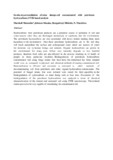Please use this identifier to cite or link to this item:
https://cris.library.msu.ac.zw//handle/11408/3024Full metadata record
| DC Field | Value | Language |
|---|---|---|
| dc.contributor.author | Mutambu, Marshall | en_US |
| dc.contributor.author | Masaka, Johnson | en_US |
| dc.contributor.author | Mhindu, Rangarirayi | en_US |
| dc.contributor.author | Musekiwa, N. | en_US |
| dc.date.accessioned | 2018-05-07T09:29:29Z | - |
| dc.date.available | 2018-05-07T09:29:29Z | - |
| dc.date.issued | 2017 | - |
| dc.identifier.issn | 4125-0851 | - |
| dc.identifier.uri | https://www.researchgate.net/publication/317400797 | - |
| dc.identifier.uri | http://hdl.handle.net/11408/3024 | - |
| dc.description.abstract | Hydrocarbons from petroleum products are a potential source of pollution of soil and water sources when they are discharged erroneously or carelessly into the environment. The petroleum hydrocarbons are also associated with heavy metals making them more hazardous to the environment. Once these petroleum hydrocarbons are in the soil they will leach and pollute the surface and underground water which are sources of water for domestic use by human beings and animals. Organic hydrocarbons can persist in the environment for many years before they naturally degrade to less harmful products, therefore food webs are also affected in the process resulting in ill health of people in those particular localities. Biodegradation of petroleum hydrocarbons contaminated soil using fungi strains that have been bio-stimulated has been adopted world over as compared to physical and chemical methods of treating contaminated soil. Bioremediation is efficient and economic as compared to other methods of decontaminating soil from petroleum and other organic hydrocarbon contaminants. The potential of fungal strains that were isolated were tested for their capability in the biodegradation of hydrocarbons on mine dump soils at four sites. Evaluation of the biodegradation of the petroleum hydrocarbons was analysed in terms of chemical characterization of the treated and untreated soil using FTIR spectroscopy. The isolated strains proved to be very capable of remediating the contaminated soil. | en_US |
| dc.language.iso | en | en_US |
| dc.publisher | International Institute for Science Technology and Education | en_US |
| dc.relation.ispartofseries | Journal of Natural Sciences Research;Vol.2, No.12; p. 1-12 | - |
| dc.subject | Biodegradation | en_US |
| dc.subject | Fungal strains | en_US |
| dc.subject | Petroleum hydrocarbons | en_US |
| dc.title | In-situ mycoremediation of mine dumps soil contaminated with petroleum hydrocarbons: FTIR based analysis | en_US |
| dc.type | text | en_US |
| item.languageiso639-1 | en | - |
| item.openairetype | text | - |
| item.fulltext | With Fulltext | - |
| item.grantfulltext | open | - |
| item.openairecristype | http://purl.org/coar/resource_type/c_18cf | - |
| item.cerifentitytype | Publications | - |
| Appears in Collections: | Research Papers | |
Files in This Item:
| File | Description | Size | Format | |
|---|---|---|---|---|
| land and water.pdf | Abstract | 5.88 kB | Adobe PDF |  View/Open |
Page view(s)
162
checked on Dec 9, 2025
Download(s)
34
checked on Dec 9, 2025
Google ScholarTM
Check
Items in MSUIR are protected by copyright, with all rights reserved, unless otherwise indicated.



